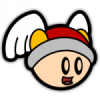Hi,
I can tell you, how I start. Eventually, it helps you.
Basically, the most important thing to know is, which size you need per sprite (use a power of 2 ideally) to prevent drawing sprites multiple times. But that's off topic i guess.
It is a nice idea to start with the background and draw your way to the front sprites (such as the character and other objects) because of the colors. This way, you make sure, the different layers have fitting colors.
On the other side, I prefer starting with my characters, since I want to focus on key features like movement, actions, etc. pretty early. For the tiles, I use templates or maybe I draw them quickly (knowing, I will replace them).
I would suggest, your artist should start with the sprites for the things you are going to implement first. If you want a moving character pretty early, he should draw the character. If you want to focus on the environment first, then it is obvious to start with the backgrounds and tiles.
Your work plan for the artist ideally goes hand in hand with your plan to implement stuff. You want to make sure, you can always implement your features without waiting for the artist.









